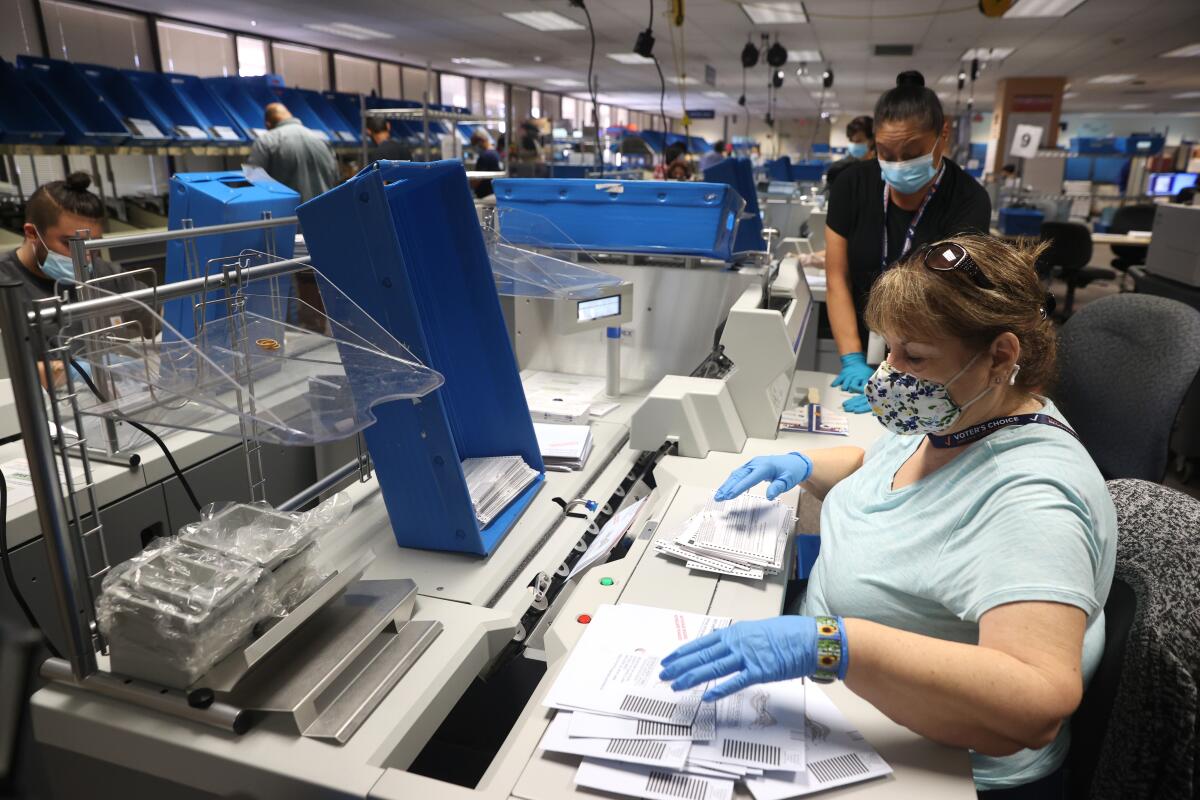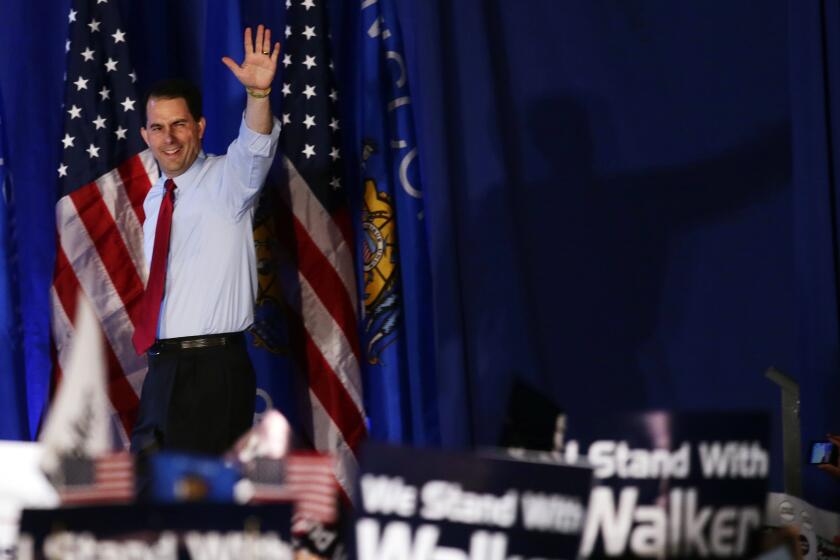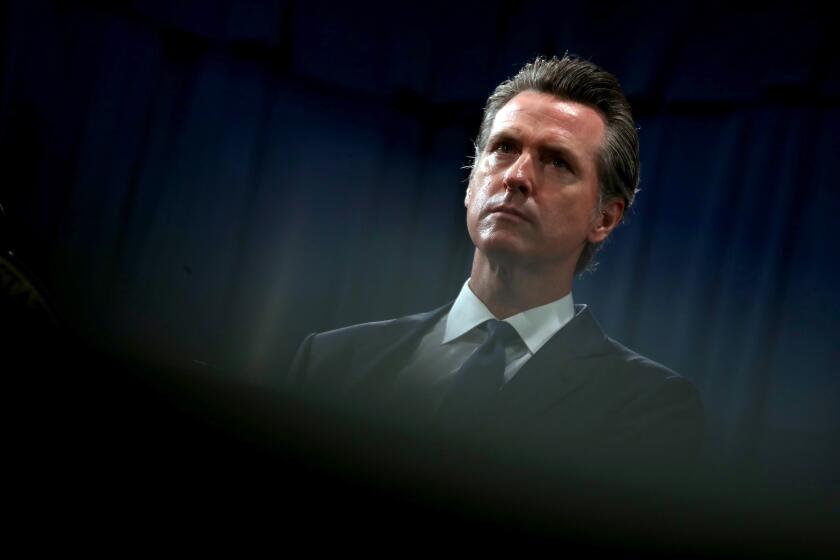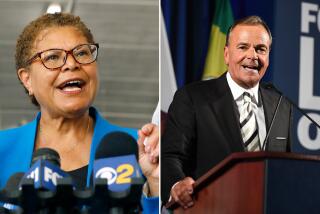Who’s voted so far in the California recall? Lots of Democrats, few young people

- Share via
With the recall election less than two weeks away, the mail ballot returns so far show that more than twice as many Democrats have voted than Republicans and that liberal areas of the state such as the Bay Area have the highest rates of return, according to state officials and political data researchers.
The early numbers provide good news for Gov. Gavin Newsom. But they also show his weaknesses and what his campaign must do between now and election day on Sept. 14 — turn out young and Latino voters — key parts of the coalition he needs to stay in office but notoriously difficult populations to mobilize in nonpresidential elections.
“If I am the Newsom campaign, I have to feel good about these numbers, but I think it’s a big mistake for them to be overly optimistic,” said Paul Mitchell, vice president of Political Data Inc. “The remaining task ahead has to look steep — you’re starting to look at voters who are really challenging to turn out…. And if this represents Republicans holding onto their ballots and waiting to vote at the polls, then we can be in for some real shifting in numbers.”
Kamala Harris struggles in public opinion polls. Voters in Pennsylvania locales essential in the Democratic Party electoral map help explain why.
The ballot-tracking details in this story are drawn from the secretary of state’s office as well as Mitchell’s firm and L2, two political data companies that analyze state and county election voter information as well as consumer and other data sources to provide analysis of the electorate.
Every registered voter was mailed a ballot because of the pandemic; four-fifths have yet to cast them. While it’s possible to know who has voted, there is no way to know how they voted.
These numbers represent a snapshot in time: Nearly 4.7 million Californians have cast ballots. The returns show that Democrats are turning out in high numbers — 2.5 million have cast ballots, compared with more than 1.1 million Republicans. Los Angeles County, the largest in the state, is lagging — 16.5% of voters have returned ballots, compared with rates in the high 20s in counties like Marin, San Francisco and Sonoma. Voters in the purple suburbs of cities like Los Angeles are also highly represented.
Polling showed that Democrats are less motivated to vote than Republicans but the healthy numbers show that Democrats “are not unenthusiastic,” said Robb Korinke, a principal with Grassroots Lab, a public affairs firm that conducts research on state and local governments. “They’re certainly not asleep.”
Democrats make up 46.5% of registered voters in California, while Republicans account for 24.1% and those who express no party preference are 23.3%. Given the Democratic registration edge, Republicans would have to “catch them snoozing for this to work,” Korinke said. “They’d practically have to find them in a coma.”
The voters who have returned their ballots are older and whiter than the overall electorate. While seniors (those ages 65 or older) are 23% of the electorate, they have cast 40% of the vote. Young adults (those 18 to 34) are the largest age-based voting bloc at 28% of registered voters, but they are responsible for just 14% of the ballots cast.
Latino voters, who tend to be younger, are also underperforming — while they make up more than a quarter of the electorate, they represent less than a fifth of people who have returned their ballots. Republicans clearly hope to make inroads with this demographic. Nationally syndicated conservative radio host Larry Elder, the front-runner among candidates seeking to replace Newsom, and former San Diego Mayor Kevin Faulconer are airing Spanish-language ads. Elder is also holding a news conference Wednesday focused on Latino voters.
“That is a place where there are red flags for Newsom and if you were going to see large Democratic defections, I would put my money more in the Latino community than I would say the senior community or young voters,” Korinke said.
Nathan Click, a spokesman for the anti-recall committee, said the campaign is pleased by the numbers but also understand there is work to do. As part of what he described as the largest voter turnout effort in state history, he said they are spending eight figures on mobilizing voters in communities of color, including a $1-million campaign aimed at young Latinos announced on Monday by Voto Latino. They have also used celebrities such as singer Katy Perry, comedian George Lopez as well as social media influencers to reach out to these groups.
“It’s really, really early but these are the first indications that Democrats are motivated, they’re energized,” Click said. “Our strategy seems to be working. But we’re not taking anything for granted.”
Scott Walker is the only governor in U.S. history to successfully beat a recall. Gavin Newsom’s campaign is trying to emulate his success, but there are key differences in the dynamics.
Recall proponents argue that the gap between Democrats and Republicans is declining, and they expect a large turnout on election day. The special election, taking place in September at a time the electorate is not used to casting ballots, also occurs amid a national reversal of voting norms: Republicans used to vote early by mail while Democrats tended to vote in person on election day. Former President Trump upended this tradition when he questioned the integrity of mail voting.
Recall supporters also argue that the early numbers favored Democrats because Los Angeles and San Francisco counties sent out their mail ballots earlier than other parts of the state.
Newsom unveiled an ad on Monday featuring Vermont Sen. Bernie Sanders, which means he’s still trying to motivate his base, not persuade centrist voters, said Anne Hyde Dunsmore, campaign manager for Rescue California, one of the main recall groups.
“We’re trending in a really good way,” she said.
The attempted recall of Gov. Gavin Newsom will go before voters on Sept. 14. Here are the details.
Among the key pieces of data to watch over the next two weeks is turnout level — the higher it grows, the higher Newsom’s chances of remaining in office because of the huge Democratic voting edge in the state. Another key indicator is whether voters continue to be older and suburban, said Paul Westcott, executive vice president at L2.
“That’s not a good trend for Democrats right now,” he said. “A lot of people will sweep in at the end. If it’s young people, Gavin Newsom is safe. If not, and if these suburbs keep voting and this trend continues, it’s going to be extremely tight.”
Jessica Patterson, chair of the state Republican Party, said that while she would prefer GOP voters turn in their ballots early, she empathizes with their desire to wait until election day.
“Certainly, the president had made a lot of comments that people want to have faith in their elections, they want to have faith in turning in their ballots, or voting in person. And so we understand — a lot of our votes are going to come in late,” she said in an interview shortly after rallying volunteers in Newport Beach last weekend. “We’re comfortable with it, we’re doing everything that we can on the ballot harvesting.”
One woman in the crowd asked what she should do if a voter handed her a completed ballot.
“Take it!” Patterson responded.
Times staff writer Julia Wick contributed to this report.
More to Read
Get the L.A. Times Politics newsletter
Deeply reported insights into legislation, politics and policy from Sacramento, Washington and beyond. In your inbox three times per week.
You may occasionally receive promotional content from the Los Angeles Times.















